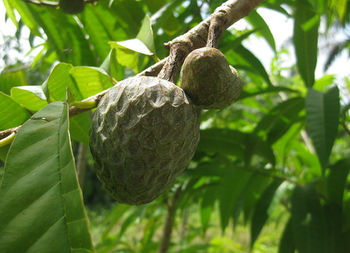Custard Apple
From Wikiwel
Other Names : Annona reticulata
The custard apple grown in Australia is a hybrid of the Sugar Apple (Annona squamosa) and the Cherimoya (Annona cherimola). More recently, hybrids have also been developed with Annona reticulata. For centuries, Ayurvedic practitioners in India have extensively use various parts of the Sugar Apple (Annona squamosa) tree for the management of diabetes. Similarly, Inca tribes in the Peruvian Andes have used cherimoya (Annona cherimola) as a medicinal plant.
Special Precautions of Custard Apple
- Obese people should avoid eating custard apple as it is a healthy food to gain weight.
- The kernel of the fruit is toxic
Health benefits and Uses of Custard Apple
- Custard apple appears to possess potent bioactive principles in most of its plant parts (fruit, seed and leaves).
- Based on in vitro and in vivo testing, custard apple fruit exhibit potent anti-diabetic, anti-obese, anti-microbial and anti-cancer properties.
- In Okinawan longevity studies, custard apple was identified as one of the few foods with anti-obese activity. In animal studies, it reduced abdominal fat tissue by about 20%.
- Aqueous extract of fruits of Annona reticulata were shown to be highly protective against chemical induced heart damage of rats. In animal studies, custard apple fruit have been shown to reduce total cholesterol by 46%, triglycerides by up to 65% and the triglyceride/HDL ratio, a major predictor of heart disease in humans by half.
- In anti-diabetic studies on animals, custard apple appears to mimic insulin stimulating its production and enhanced uptake of glucose by muscles leading to stabilisation of blood sugar concentrations.
- Animal studies have shown that feeding sugar apple (Annona squamosa) pulp increased haemoglobin levels by up to 21%. This response, if translated to humans, could provide a significant boost to athlete performance.
- In vitro studies have shown that the fruit of Annona spp. have significant anti-microbial activities against a range of serious pathogens.
- Currently the Annonaceae remain a "hot' family for the discovery of new anti-cancer drugs. Custard apple contains a class of chemicals called acetogenins, which are very long chain fatty acids, and only found in Annonaceous species. In vivo testing has shown that bullatacin, an acetogenin found in custard apple, to be 300 times more potent than Taxol (paclitaxel), a standard anti-cancer drug.
- Limited human clinical testing trials are being conducted on the closely related Annonaceous species Asimina triloba (North American pawpaw) at the Nevada Cancer Clinic in the USA (visit www.pawpaw.research.com site for details). Early findings appear promising.
- Few fruits or foods possess the wide range of bioactivity exhibited by custard apple fruit and potentially it appears to be equal or even greater other superfruits such as blueberry. Custard apple fruit can be processed into a range of health products from purees to cereal flakes to spray-dried powder. Processed products may have a higher concentration of bioactive chemicals.
- Even though there have been limited animal and human studies, custard apple appear to be have excellent health and medicinal benefits which deserve to be further explored.
- The leaves are used internally against worms, and externally to treat abscesses
- Crushed leaves or a paste of the flesh may be poulticed on boils, abscesses and ulcers.
- Unripe fruits and the bark are rich in tannin. They are used to treat diarrhoea and dysentery. In severe cases, the leaves, bark and green fruits are all boiled together for 5 minutes in a litre of water to make an exceedingly potent decoction.
- Fragments of the root bark are put around the gums to relieve toothache.
- The root decoction is taken as a febrifuge
- The finely grated stem bark is placed on the area of an enlarged spleen.
- A concentrated extract of the see is employed to remedy dysentery and diarrhoea.
